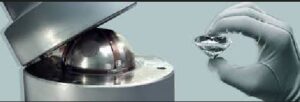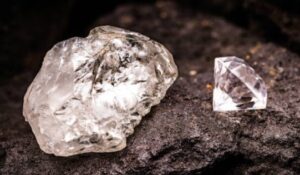Natural Diamonds
Natural diamonds are formed by the heat and pressure of the Earth, from 1 to 3 billion years ago, making a natural diamond the oldest thing you will ever touch.
The cost of mining, sorting, cutting, polishing and distribution of natural diamonds have a cost that exceeds that of man-made diamonds. Therefore, the residual value of a Natural diamond will always be greater.
Natural diamond companies are committed to controlling and reducing their environmental impact, as well as protecting through conservation projects three times more land than they use.
The natural diamond industry supports the livelihood of 10 million people globally. Together, the world’s leading diamond producers create $16 billion net positive socioeconomic and environmental benefits annually in countries where they operate–80% of which stays within local communities.
Researchers are using the rocks in which diamonds are found called kimberlite to absorb carbon dioxide from the atmosphere, in a ground-breaking research program with the aim to reach carbon neutrality within this decade.
The environmental impact of a one carat, polished natural diamond is about the same as the environmental impact in manufacturing 3 smartphones.
Lab Grown Diamonds
What is Lab-Grown Diamond?
Lab-Grown Diamonds are optically, chemically, and physically, identical to natural diamonds and are created in a lab by scientists. Lab-grown diamonds provide the same luxurious diamond at flexible price points to fit anyone’s lifestyle. Lab-grown diamonds also offer the opportunity of a larger carat weight at lower costs.
Lab-Grown Diamonds with GIA or IGI Reports have a Laser inscribed ID number that offers the ultimate safeguard.
What Is the Difference Between Lab-Grown and Natural Diamonds?
Optically:
Indistinguishable from the naked eye, lab-grown diamonds present the same visible qualities as their natural counterparts.
Chemically:
Lab-grown diamonds are not simulants. They are formed from rough crystals taking an average of 2–4 weeks.
Physically:
To confidently tell lab-grown and natural diamonds apart, advanced instruments are needed to detect the physical aspects.
How are Lab-Grown Diamonds Created?
Lab-Grown Diamond manufacturers operate in highly controlled lab environments using one of two methods: High Pressure High Temperature (HPHT) or Chemical Vapor Deposition (CVD).
Both processes begin with a diamond seed and result in a Lab-Grown Diamond. During the HPHT method, the scientist places the diamond seed in a growth chamber (apparatus), heats it to 2,700–3,100 degrees Fahrenheit, and exposes the seed to a pressure of 725,000 pounds per square inch, similar to the process that takes place in Earth’s mantle. The diamond seed remains under these intense conditions for varying lengths of time.
The CVD method of Lab-Grown Diamond creation begins with flat diamond slabs placed in a reactor. The reactor is injected with Methane gas. The gas is exposed to microwaves which cause it to break down into its comprising atoms and generate a carbon-rich plasma cloud. The carbon atoms in the plasma connect with the diamond slabs and create new layers, resulting in slow vertical growth.
Both the HPHT process and the CVD process produce Type IIa colorless Lab-Grown Diamonds, equal to some of the rare and sought-after types of Natural Diamond. These processes can also be adjusted to produce colored Lab-Grown Diamonds.
Summary
The residual value of a Lab Grown diamond is increasingly difficult to know in the future. The cost to produce each one has become stable enough in the last few years that the industry, in general, has been much more accepting of the market pricing.
The original man-made diamonds produced by General Electric back in the 1950’s were about 10 times the cost to actually mine a rough diamond! Today, the cost is about 10 times less in some cases.
We tell our clients that the cost is so much less for a man made diamond, it may be a more suitable purchase for our younger generations dreaming of a furnished house!
One very important note is that we cannot guarantee that the value of a Lab Grown Diamond will be sustainable in the future. However, the cost to physically mine natural diamonds will continue to be more expensive because of input costs.
Either way, we are happy to discuss the options available.
For more information:
https://www.naturaldiamonds.com/diamond-guide/natures-difference/



